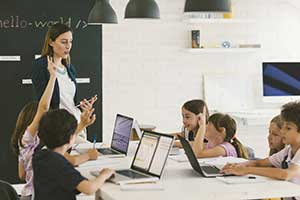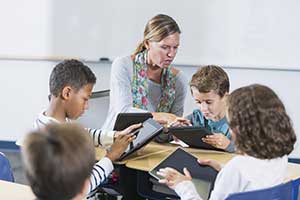Game Based Learning (GBL) and the blended classroom have become increasingly popular instructional options as teachers strive to improve teaching and learning. These two instructional forms complement each other well. Both serve the 21st century classroom by engaging students in their education and giving them opportunities to develop not only basic curriculum mastery but also critical thinking and problem solving skills.
GBL uses games to aid students’ learning. Although GBL can drastically transform instruction, as in the case of using World of Warcraft to teach humanities, GBL can be as simple as playing Jeopardy to review materials before summative assessment. Both applications involve games to complement or replace more traditional instructional methods, such as lectures, Q&As, and worksheets.
Most teachers employ some form of GBL. However, we must be careful not to confuse GBL with gamification. In gamification, a teacher incorporates the mechanics of game play and game design into the curriculum. Teachers who espouse GBL take a very different approach. They infuse the curriculum with games, and the games become primary methods to introduce, explore, explain, and reinforce material.
What Is Blended Learning?
Blended learning fuses online and traditional “brick and mortar” instruction. Some teachers assume using technology equals a blended classroom; however, blended learning should be viewed as more of a spectrum between traditional “brick and mortar” instruction on one end and online-only classes on the other.
Most truly blended classrooms feature 1) students who access some class content and instruction online outside of the traditional time and space of the classroom, and 2) a Classroom Management System (CMS) such as Edmodo or Moodle.

Game Based Learning & Blended Learning In Practice
GBL fits seamlessly into a blended instructional model. Games can act as bridges between the physical, face-to-face environment and an online classroom in at least three ways.
Independent Game Play Outside Of Class
First, a student could play games independently, outside the regular class time and setting. Sites like Quizizz and Quizlet have popularized this method. For this to be successful, teachers must possess some way to track student progress and learning. This usually occurs in the form of tracking time spent on the game and assessing students’ answers and feedback to questions.
Teachers Meeting With Students Virtually
 Second, a teacher could meet with students in a virtual environment. Examples of such environments include Minecraft: Education Edition and Second Life. With this method, the teacher schedules a time to meet in a virtual space within the game. Students and teacher are therefore in different places but meeting at the same time. The mode of instruction varies depending on the virtual environment and game limitations. A lecture is possible in Second Life, for example, but not Minecraft.
Second, a teacher could meet with students in a virtual environment. Examples of such environments include Minecraft: Education Edition and Second Life. With this method, the teacher schedules a time to meet in a virtual space within the game. Students and teacher are therefore in different places but meeting at the same time. The mode of instruction varies depending on the virtual environment and game limitations. A lecture is possible in Second Life, for example, but not Minecraft.
Students Meeting & Playing Together In A Game Environment
Third, a student could meet and play with other students in a game environment without teacher supervision. The situation arises when students are assigned collaborative Minecraft projects or asked to compete against other students in some games found on ABCya!.
Benefits Of Game-Based Learning In Blended Learning Classrooms
GBL perfectly suits a blended classroom framework. With it, teachers meet students’ expectations—today’s students already “game” with other students. Teachers also overcome challenges found with typical homework assignments and assessments.
Games can reduce testing anxiety and increase student motivation to engage and learn. In fact, some teachers see students playing games outside of class sheerly for the joy of it. For those reasons and many more, game based learning will become a more common mode of instruction that extends learning beyond the classroom.
Scott Beiter teachers science at Rensselaer Jr. Sr. High in Rensselaer, New York. Follow his blog, Full Sail Science, to learn more.



